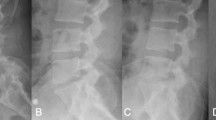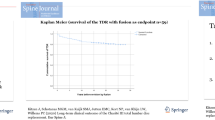Abstract
The aim of our prospective non-randomized clinical study was to analyze operative data, short-term results, safety, efficacy, complications, and prognostic factors for single-level total lumbar disc replacement (TLDR), and to compare results between different levels (L4–L5 vs. L5–S1). Thirty-six patients with single-level L4–L5 or L5–S1 TLDR, with 1-year minimum follow-up (FU), had complete clinical [SF36, visual analog scale (VAS), Oswestry Disability Index (ODI)] and radiological data, and were included in our study. Mean FU was 38.67 ± 17.34 months. Replaced level was L4–L5 in 12 (33.3%) cases, and L5–S1 in 24 cases (66.7%). Mean age at diagnosis was 41.17 ± 7.14 years. 24 (66.7%) were females and 12 (33.3%) were males. Statistical analyses were assessed using t tests or Mann–Whitney test for continuous variables and Chi-square test or Fisher’s exact test analyses for categorical variables. Univariate linear regression and binary logistic regression analyses were utilized to evaluate the relationship between surgical outcomes and covariates (gender, age, etiology, treated level, pre-operative SF36, ODI, and VAS). Mean operative time was 147.03 ± 30.03 min. Mean hospital stay was 9.69 ± 5.39 days, and mean return to ambulation was 4.31 ± 1.17 days. At 1-year FU, patients revealed a statistical significant improvement in VAS pain (P = 0.000), ODI lumbar function (P = 0.000), and SF36 general health status (P = 0.000). Single-level TLDR is a good alternative to fusion for chronic discogenic low back pain refractory to conservative measures. Our study confirmed satisfactory clinical results for monosegmental L4–L5 and L5–S1 disc prosthesis, with no difference between the two different levels for SF36 (P = 0.217), ODI (P = 0.527), and VAS (P = 0.269). However, replacement of the L4–L5 disc is affected by an increased risk of complication (P = 0.000). There were no prognostic factors for intraoperative blood loss or return to ambulation. Age (P = 0.034) was the only prognostic factor for operative time. Hospital stay was affected by level (P = 0.036) and pre-op VAS (P = 0.006), while complications were affected by the level (P = 0.000) and pre-op ODI (P = 0.049). Complete pre-operative assessment (in particular VAS and ODI questionnaires) is important because more debilitating patients will have more hospital stay and higher complications or complaints. Patients had to be informed that complications, possibly severe, are particularly frequent (80.6%).





Similar content being viewed by others
References
Atlas SJ, Nardin RA (2003) Evaluation and treatment of low back pain: an evidence-based approach to clinical care. Muscle Nerve 27:265–284
Bertagnoli R, Kumar S (2002) Indications for full prosthetic disc arthroplasty: a correlation of clinical outcome against a variety of indications. Eur Spine J 11:S131–S136
Bertagnoli R, Marnay T, Mayer HM (eds) (2003) Total disc replacement. Spine Solutions GmbH, Tuttlingen
Bertagnoli R, Yue JJ, Shah RV, Nanieva R, Pfeiffer F, Fenk-Mayer A, Kershaw T, Husted DS (2005) The treatment of disabling single-level lumbar discogenic low back pain with total disc arthroplasty utilizing the Prodisc prosthesis: a prospective study with 2-year minimum follow-up. Spine 30:2230–2236
Block AR, Vanharanta H, Ohnmeiss DD, Guyer RD (1996) Discographic pain report. Influence of psychological factors. Spine 21:334–338
Blumenthal S, McAfee PC, Guyer RD, Hochschuler SH, Geisler FH, Holt RT, Garcia R Jr, Regan JJ, Ohnmeiss DD (2005) A prospective, randomized, multicenter Food and Drug Administration investigational device exemptions study of lumbar total disc replacement with the CHARITE artificial disc versus lumbar fusion: part I: evaluation of clinical outcomes. Spine 30:1565–1575
Boden SD, Balderston RA, Heller JG, Hanley EN Jr, Zigler JE (2004) An AOA critical issue. Disc replacement: this time will we really cure low back and neck pain. J Bone Joint Surg Am 86:411–422
Bono CM, Lee CK (2004) Critical analysis of trends in fusion for degenerative disc disease over the past 20 years: influence of technique on fusion rate and clinical outcome. Spine 29:455–463
Carragee EJ, Tanner CM, Yang B, Brito JL, Truong T (1999) False-positive findings on lumbar discography. Reliability of subjective concordance assessment during provocative disc injection. Spine 24:2542–2547
Carregee EJ, Paragioudakis SJ, Khurana S (2000) 2000 Volvo Award winner in clinical studies: lumbar high-intensity zone and discography in subjects without low back problems. Spine 25:2987–2992
Cauchoix J, David T (1985) Arthrodeses lombaires: resultats apres plus de 10 ans. Rev Chir Orthop 71:263–268
Cherkin DC, Sherman KJ, Deyo RA, Shekelle PG (2003) A review of the evidence for the effectiveness, safety, and cost of acupuncture, massage therapy, and spinal manipulation for back pain. Ann Intern Med 138:898–906
Chung SS, Lee CS, Kang CS (2006) Lumbar total disc replacement using ProDisc-II: a prospective study with a 2-year minimum follow-up. J Spinal Disord Tech 19:411–415
Cinotti G, David T, Postacchini F (1996) Results of disc prosthesis after a minimum follow-up period of 2 years. Spine 21:995–1000
David T (1993) Lumbar disc prosthesis. Eur Spine J 1:254–259
David T (2005) Revision of a Charité artificial disc 9.5 years in vivo to a new Charité artificial disc: case report and explant analysis. Eur Spine J 14:507–511
David T (2007) Long term results of one-level lumbar arthroplasty. Minimum 10-year follow-up of the Charité artificial disc in 106 patients. Spine 32:661–666
Delamarter RB, Fribourg DM, Kanim LE, Bae H (2003) ProDisc artificial total lumbar disc replacement: introduction and early results from the United States clinical trial. Spine 28:S167–S175
Delamarter RB, Bae HW, Pradhan BB (2005) Clinical results of ProDisc-II lumbar total disc replacement: report from the United States Clinical Trial. Orthop Clin North Am 36:301–313
Denoziere G, Ku DN (2006) Biomechanical comparison between fusion of two vertebrae and implantation of an artificial intervertebral disc. J Biomech 39:766–775
Dooris AP, Goel VK, Grosland NM, Gilbertson LG, Wilder DG (2001) Load-sharing between anterior and posterior elements in a lumbar motion segment implanted with an artificial disc. Spine 26:E122–E129
Freeman BJ, Davenport J (2006) Total disc replacement in the lumbar spine: a systematic review of the literature. Eur Spine J 15:S439–S447
Frelinghuysen P, Huang RC, Girardi FP, Cammisa FP Jr (2005) Lumbar total disc replacement part I: rationale, biomechanics, and implant types. Orthop Clin North Am 36:293–299
Fritzell P, Hägg O, Wessberg P, Nordwall A, Swedish Lumbar Spine Study Group (2001) 2001 Volvo Award Winner in Clinical Studies: lumbar fusion versus nonsurgical treatment for chronic low back pain: a multicenter randomized controlled trial from the Swedish Lumbar Spine Study Group. Spine 26:2521–2532
Griffith SL, Shelokov AP, Büttner-Janz K, LeMaire J-P, Zeegers WS (1994) A multicenter retrospective study of the clinical results of the LINK® SB Charité intervertebral prosthesis. The initial European experience. Spine 19:1842–1849
Guigui P, Lambert P, Lassale B, Deburge A (1997) Long-term outcome at adjacent levels of lumbar arthrodesis. Rev Chir Orthop Reparatrice Appar Mot 83:685–696
Hagg O, Fritzell P (2004) Re: Brox JI, Sörensen R, Friis A, et al. Randomized clinical trial of lumbar instrumented fusion and cognitive intervention and exercises in patients with chronic low back pain and disc degeneration. Spine 28:1913–1921. Spine 29:1160–1161
Hannibal M, Thomas DJ, Low J, Hsu KY, Zucherman J (2007) ProDisc-L total disc replacement: a comparison of 1-level versus 2-level arthroplasty patients with a minimum 2-year follow-up. Spine 32:2322–2326
Huang RC, Tropiano P, Marnay T, Giradi FP, Lim MR, Cammisa FPJ (2006) Range of motion and adjacent level degeneration after lumbar total disc replacement. Spine J 6:242–247
Kumar MN, Baklanov A, Chopen D (2001) Correlation between sagittal plane changes and adjacent segment degeneration following lumbar spine fusion. Eur Spine J 10:314–319
Kumar MN, Jacquot F, Hall H (2001) Long-term follow-up of functional outcomes and radiographic changes at adjacent levels following lumbar spine fusion for degenerative disc disease. Eur Spine J 10:309–313
Lee CK (1988) Accelerated degeneration of the segment adjacent to a lumbar fusion. Spine 13:375–377
Lehman RA Jr, Lenke LG (2007) Long-segment fusion of the thoracolumbar spine in conjunction with a motion-preserving artificial disc replacement: case report and review of the literature. Spine 32:E240–E245
Le Huec JC, Mathews H, Basso Y, Aunoble S, Hoste D, Bley B, Friesem T (2005) Clinical results of Maverick lumbar total disc replacement: two-year prospective follow-up. Orthop Clin North Am 36:315–322
Lemaire JP, Skalli W, Lavaste F, Templier A, Mendes F, Diop A, Sauty V, Laloux E (1997) Intervertebral disc prosthesis: results and prospects for the year 2000. Clin Orthop Relat Res 337:64–76
Mayer HM, Wiechert K (2002) Microsurgical anterior approaches to the lumbar spine for interbody fusion and total disc replacement. Neurosurgery 51:159–165
McAfee PC, Fedder IL, Saiedy S, Shucosky EM, Cunningham BW (2003) SB Charité disc replacement: report of 60 prospective randomized cases in a US center. J Spinal Disord Tech 16:424–433
McAfee PC, Geisler FH, Saiedy SS, Moore SV, Regan JJ, Guyer RD, Blumenthal SL, Fedder IL, Tortolani PJ, Cunningham B (2006) Revisability of the Charité artificial disc replacement: analysis of 688 patients enrolled in the U.S. IDE study of the Charité artificial disc. Spine 31:1217–1226
Mehren C, Suchomel P, Grochulla F, Barsa P, Sourkova P, Hradil J, Korge A, Mayer HM (2006) Heterotopic ossification in total cervical artificial disc replacement. Spine 31:2802–2806
Pai S, Sundaram LJ (2004) Low back pain: an economic assessment in the United States. Orthop Clin North Am 35:1–5
Punt IM, Visser VM, van Rhijn LW, Kurtz SM, Antonis J, Schurink GW, van Ooij A (2007) Complications and reoperations of the SB Charité lumbar disc prosthesis: experience in 75 patients. Eur Spine J doi:10.1007/s00586-007-0506-8
Regan JJ (2005) Clinical results of Charité lumbar total disc replacement. Orthop Clin North Am 36:323–340
Ross R, Mirza AH, Norris HE, Khatri M (2007) Survival and clinical outcome of SB Charité III disc replacement for back pain. J Bone Joint Surg Br 89:785–789
SariAli el-H, Lemaire JP, Pascal-Mousselard H, Carrier H, Skalli W (2006) In vivo study of the kinematics in axial rotation of the lumbar spine after total intervertebral disc replacement: long term results A 10–14 years follow-up evaluation. Eur Spine J 15:1501–1510
Siepe CJ, Mayer HM, Wiechert K, Korge A (2006) Clinical results of total lumbar disc replacement with ProDisc-II: three-year results for different indications. Spine 31:1923–1932
Siepe CJ, Mayer HM, Heinz-Leisenheimer M, Korge A (2007) Total lumbar disc replacement. Different results for different levels. Spine 32:782–790
Siepe CJ, Korge A, Grochulla F, Mehren C, Mayer HM (2007) Analysis of post-operative pain patterns following total lumbar disc replacement: results from fluoroscopically guided spine infiltrations. Eur Spine J doi:10.1007/s00586-007-0519-3
Tortolani PJ, Cunningham BW, Eng M, McAfee PC, Holsapple GA, Adams KA (2007) Prevalence of heterotopic ossification following total disc replacement. A prospective, randomized study of two hundred and seventy-six patients. J Bone Joint Surg Am 89:82–88
Tropiano P, Huang RC, Girardi FP, Cammisa FP Jr, Marnay T (2005) Lumbar total disc replacement. Seven to eleven-year follow-up. J Bone Joint Surg Am 87:490–496
Turner JA, Ersek M, Herron L, Haselkorn J, Kent D, Ciol MA, Deyo R (1992) Patient outcomes after lumbar spinal fusions. JAMA 268:907–911
van Gijn J, van der Mast RC (2007) Chronic low back pain: the failure of organic medicine. Ned Tijdschr Geneeskd 151:1553–1556
van Ooij A, Schurink GW, Oner FC, Verbout AJ (2007) Findings in 67 patients with recurrent or persistent symptoms after implantation of a disc prosthesis for low back pain. Ned Tijdschr Geneeskd 151:1577–1584
Zeegers WS, Bohnen LM, Laaper M, Verhaegen MJ (1999) Artificial disc replacement with the modular type SB Charité III: 2-year results in 50 prospectively studied patients. Eur Spine J 8:210–217
Zigler JE, Burd TA, Vialle EN, Sachs BL, Rashbaum RF, Ohnmeiss DD (2003) Lumbar spine arthroplasty: early results using the ProDisc II: a prospective randomized trial of arthroplasty versus fusion. J Spinal Disord Tech 16:352–361
Zigler JE (2004) Lumbar spine arthroplasty using the ProDisc II. Spine J 4:S260–S267
Acknowledgment
Authors thank Paola Di Stefano, Ph.D., for statistical analysis.
Conflict of interest statement
None of the authors has any potential conflict of interest.
Author information
Authors and Affiliations
Corresponding author
Rights and permissions
About this article
Cite this article
Sinigaglia, R., Bundy, A., Costantini, S. et al. Comparison of single-level L4–L5 versus L5–S1 lumbar disc replacement: results and prognostic factors. Eur Spine J 18 (Suppl 1), 52–63 (2009). https://doi.org/10.1007/s00586-009-0992-y
Accepted:
Published:
Issue Date:
DOI: https://doi.org/10.1007/s00586-009-0992-y




